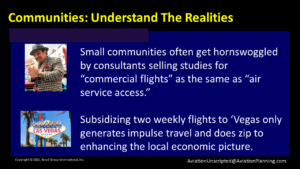The Red Way Airline Collapse.
Lessons Learned?
Or $3 Million Wasted On Civic Hubris & Bad Data?
The sudden failure of the Red Way airline experiment at Lincoln, Nebraska has delivered a whole passel of new perspectives on the potential of rural and regional air access.
The question is whether anybody is paying attention.
Civic Hubris v Reality. It’s important to recognize that Lincoln did indeed take up the cudgel and attempt a new approach to air service access. But it’s also necessary to note that there were some massive shortfalls in planning and implementation. Shortfalls that were not hidden, but which were clearly ignored. Civic rah-rah apparently took the place of hard analyses.
It has nothing to do with the convoluted semi-charter approach to getting airplanes at the gate. It’s all about true passenger demand and consumer options. The Red Way traffic experience is a valuable learning experience for all communities involved in trying to increase air service access.
The question is whether these lessons were learned or are just being ignored. Let’s take a look at what the Red Way experiment has illuminated.
The Don’t Hear Thunder Dynamic. The entire experiment was a success only in attracting and transporting sailboat fuel, not much more. Yet at least one usual-contributor to the web-kibitzing genre has lamented this failure, because, it claimed, “Lincoln really needed these flights.” (?)
The Cheerleader-From-The-Titanic-Poop-Deck Experience. The giant traffic vapor hole facing Red Way was almost certainly as obvious as a blemish on prom night, after the first fortnight of dispatching empty airplanes to points with not enough day-of-week passengers to fill a VW microbus.
Yet, check out the wondrous media coverage, including the perfunctory implications that the project was akin to a gold rush, with “thousands of seats sold!” Too bad nobody in the local media bothered to take a pencil to the claim. Message to local Lincoln media: your job is to report and inform, instead of being advocates for something in which you have no expertise.
The Sudden Underdog Excuses. It’s interesting to take in the various statements being issued after the service cessation announcement. In light of all the prior sunshine pronouncements, the following post-mortem missive is incredibly illuminating – emphasis added:
“…we face insurmountable challenges as a small startup in our industry, and the compounding of costs and lack of resources have made it impossible for us to sustain operations. It is our hope that other carriers see the incredible potential, and with their economies of scale, are able to provide Lincoln with the service it is so worthy of.”
Yikes. Funny, none of these against-the-odds heroics seem to be found in any of the pre-operation hype. They now claim what they faced from the start were “insurmountable” odds, and “lack of resources” – despite reportedly burning through over $900K in the first month, and supposedly $3 million total.
Galactic levels of chutzpah.
And in the hard light of having gone through a pile of public funds, it’s clear they didn’t run this statement by their legal department, either.
One point is right on, however. Other carriers will indeed get the message on the market potential.
The Mirage of The “Home Team Advantage.” Clearly, the plan was predicated on giving the folks driving on I-80 to and from OMA what they really really wanted, which was seats from Lincoln.
Regardless of the non-competitive nature of the Red Way concept, this followed a traditional consultant Pied-Piper line peddled to a lot of small communities: local service alone will have ‘em coming in droves, even if it is inferior to other air access options. Snake oil.
Final Point: Again, innovative approaches to air access should be encouraged. But when they fail it does nobody any good to try to excuse away the hard realities learned. It’s the aviation version of claiming the dog ate your homework. This Red Way program failed because it assumed a lot of factors not in evidence. Period.
Those three million bucks have some value in understanding what can and cannot be accomplished – a lesson for the future.
And, maybe not.
_________
Check Out This Week’s Aviation Unscripted
When communities get “commercial flights” confused with “air service access.”
Related to the Red Way fiasco, the latest Unscripted video takes just ten minutes to outline events like this one, and how airports can better address the future.
 At Red Way, it was obvious that other than impulse destinations such as Orlando, the day-of-week model to business destinations is nonsense for small and midsize airports.
At Red Way, it was obvious that other than impulse destinations such as Orlando, the day-of-week model to business destinations is nonsense for small and midsize airports.
Then we look at Dayton, where Avelo tossed in the towel. The question here is why the airport would spend the energy and resources to recruit an airline to offer exactly what was already in place with Allegiant.
Places like Salem and Dubuque are getting side tracked, assuming that impulse flights to Florida and ‘Vegas are “air access” when they do nothing to connect the community to the globe, and in fact benefit a small sliver of the consumer market.
Point: recruiting impulse destinations from high quality airlines like Avelo is positive. But it isn’t designed to connect communities to the globe. That is where network carrier access comes in.
Finally, we take a quick look at the JetBlue/Spirit deal and how it is really pro-competitive for the USA consumer.
Click here, spend ten minutes with us, and while there hit the follow button.